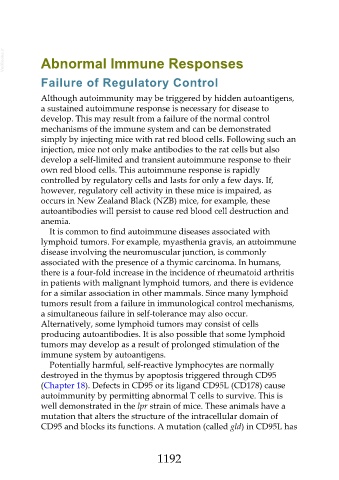Page 1192 - Veterinary Immunology, 10th Edition
P. 1192
VetBooks.ir Abnormal Immune Responses
Failure of Regulatory Control
Although autoimmunity may be triggered by hidden autoantigens,
a sustained autoimmune response is necessary for disease to
develop. This may result from a failure of the normal control
mechanisms of the immune system and can be demonstrated
simply by injecting mice with rat red blood cells. Following such an
injection, mice not only make antibodies to the rat cells but also
develop a self-limited and transient autoimmune response to their
own red blood cells. This autoimmune response is rapidly
controlled by regulatory cells and lasts for only a few days. If,
however, regulatory cell activity in these mice is impaired, as
occurs in New Zealand Black (NZB) mice, for example, these
autoantibodies will persist to cause red blood cell destruction and
anemia.
It is common to find autoimmune diseases associated with
lymphoid tumors. For example, myasthenia gravis, an autoimmune
disease involving the neuromuscular junction, is commonly
associated with the presence of a thymic carcinoma. In humans,
there is a four-fold increase in the incidence of rheumatoid arthritis
in patients with malignant lymphoid tumors, and there is evidence
for a similar association in other mammals. Since many lymphoid
tumors result from a failure in immunological control mechanisms,
a simultaneous failure in self-tolerance may also occur.
Alternatively, some lymphoid tumors may consist of cells
producing autoantibodies. It is also possible that some lymphoid
tumors may develop as a result of prolonged stimulation of the
immune system by autoantigens.
Potentially harmful, self-reactive lymphocytes are normally
destroyed in the thymus by apoptosis triggered through CD95
(Chapter 18). Defects in CD95 or its ligand CD95L (CD178) cause
autoimmunity by permitting abnormal T cells to survive. This is
well demonstrated in the lpr strain of mice. These animals have a
mutation that alters the structure of the intracellular domain of
CD95 and blocks its functions. A mutation (called gld) in CD95L has
1192

